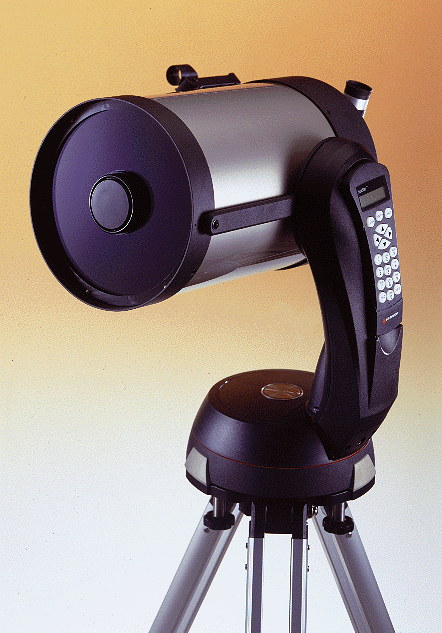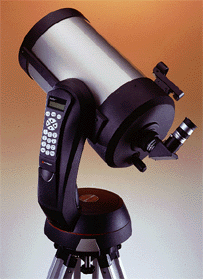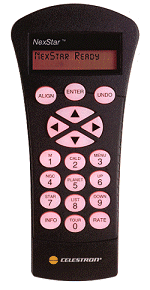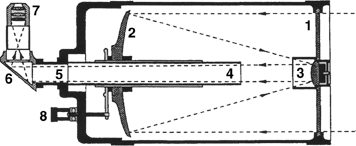Celestron History
![]() Distribution
Distribution ![]() News
News ![]() Notes & Interesting Articles
Notes & Interesting Articles ![]() Products
Products ![]() Pricing
Pricing ![]() Quality Assurance
Quality Assurance

Celestron NexStar 8 Schmidt-Cassegrain Telescope

Left: Celestron NexStar 8 viewed from front and left (36,739 bytes).
NOTE: In 1985 Celestron became the first company to offer computer-driven Schmidt-Cassegrain telescopes - the "CompuStar" series. In August 1996 their second generation of computer controlled telescope the Ultima® 2000 arrived. Celestron introduced their third generation operating system (OS) with the NexStar 5 in August 1999; since then the telescope has come to meet its advertised expectations.
We anticipated larger telescopes and in February 2000, Celestron announced the NexStar 8 - first deliveries began in March 2000. Company Seven will revise this article as is appropriate after we gain experience with production models (we already have the NexStar 8 on display). The NexStar 8 may not replace the Ultima 2000, it compliments the line with a more affordable simpler to use interface, geared for visual applications. The demand for the Ultima 2000 remains high so Celestron has made no decision on it's future.
Company Seven expects to see an 11" Fastar model, and probably an 11" using the NexStar OS following in Spring 2001 at the earliest. We will continue to accept names on our non-binding waiting list for notification when the new 11 inch telescopes become available - assuming they too meet our expectations.
Celestron developed this telescope in order to provide a relatively affordable, very easy to use "Go-To" computer controlled telescope with better rigidity than the Celestar 8 telescope. This will be a telescope to be considered by those who are interested primarily in visual applications, or for the photography of terrestrial objects including birds or other wildlife at great distances. The ability to precisely move the telescope up or down or left or right (without the astronomical clock drive continuously moving the telescope) makes this a platform to be considered for terrestrial and other applications where exact positioning is required.
The NexStar 8 (with appropriate optional hardware) is also suitable for short exposure imaging of planets, the moon or the Sun (with suitable filter). Some of the features found in the Celestar 8 Deluxe and Ultima 2000 Computer Controlled telescopes which suit them better to long term "Deep Sky" astrophotography ("Fastar" capability, CCD auto guider port, Periodic Error Control, etc.), and manual controls were purposely omitted on the NexStar in order to provide the same high quality of SCT view which Celestron is known to be capable of, with the "Go-To" capability at moderate cost. This is also the first telescope we have seen come out of Celestron where it seems that a highly competent styling designer was consulted; it is a very attractive telescope with nicely made, finished, and well fitted components.
Sophisticated Simplicity:
Click on image to see enlarged rear left side view (160,607 bytes)
The NexStar operating system is sophisticated in its engineering and programming, this is in order to make the resulting observing experience nearly "idiot proof" - simple and fun to use. Set up is quick thereby inspiring you to take the telescope out more often, while leaving you time to enjoy yourself and your observing. The complete telescope optical tube assembly with the single tine fork mount (a first for the 8 inch SCT) and the standard telescope weighs just about 21.5 lbs. (9.8 kg), the furnished lightweight aluminum field tripod adds another 10 lbs (4.6 kg). This remains a good telescope for anyone who can push a button: the youngster, or elderly astronomer on the go who can not manage the more substantial or complicated telescopes.

Note detachable Keypad Controller stored in Fork Tine (38,710 bytes).
Single Tine Fork Mount:
This is the first single tine fork ever offered with an SCT as large as this 8 inch, and yet this is a more rigid metal fork mount and base than that which is furnished with the Celestar 8 telescope. The fork tine incorporates a recessed compartment to conveniently hold the contoured NexStar Keypad Controller; one may operate this telescope with this keypad in place or remove it and then command the telescope with the keypad in hand since it remains connected to the telescope by a flexible coiled cable resembling a telephone cord. This telescope mount is not designed to be moved manually, and so all control functions should be made through commands through the keypad controller.
The adjustable height lightweight aluminum tripod furnished by Celestron with the NexStar 8 is economical but just barely adequate. And so, Company Seven is considering the production of a superior lightweight replacement for our customers; we also offer other compatible tripods made by Celestron.
The optical encoders are fully enclosed in the fork mount; this provides for good protection of the encoders. The encoders provide continuous feed back of position to the Keypad Controller display.
We can not help buy wonder how this fork mount might be adapted with "Quick Release" hardware to accept some other telescopes such as the compact Apochromatic refractors made by TeleVue and Astro-Physics.
Electronics and Computer Software Features:
 The electronics control system includes a totally cordless, smooth moving and nearly silent drive system. User input and 16 bit computer feedback are provided through the NexStar Keypad Controller. The controller incorporates a dual line, 16 character Liquid Crystal Display (LCD) display which is back lit for easy use in the dark.
The electronics control system includes a totally cordless, smooth moving and nearly silent drive system. User input and 16 bit computer feedback are provided through the NexStar Keypad Controller. The controller incorporates a dual line, 16 character Liquid Crystal Display (LCD) display which is back lit for easy use in the dark.
Left: NexStar Hand Control (22,834 bytes).
The NexStar 8 operating system provisions include:
- database storing the location of 18,473 objects: includes entries from the Messier, NGC and Caldwell catalogs as well as planets, and selected SAO objects.
- storage memory for 25 user programmable objects: up to 5 terrestrial, and up to 20 astronomical.
- storage memory for 10 user programmable observing sites (input at site, or by entering longitude and latitude in advance).
- Tour Function: selects the best and most spectacular objects available for you to observe.
- four astronomical tracking rates: King, Sidereal, Lunar and Solar.
- nine slew or correction speeds: 6.5 degrees per second, 3 Deg./Sec., 1.5 Deg./Sec., 128X Sidereal, 64X, 16X, 8X, 2X, 1X.
- Cord Wrap protection: stops the telescope from rotating more than 360 degrees thereby preventing the wrapping an any external cord around the telescope. This menu selection may be disabled by the user when desired such as when operating the telescope from internal batteries.
- Anti Backlash: All mechanical gears have a certain amount of backlash or play between the gears. This play is evident by how long it takes for a star to move in the eyepiece when the hand control arrow buttons are pressed (especially when changing directions). The anti-backlash features allows the user to compensate for backlash by inputting a value which quickly rewinds the motors just enough to eliminate the play between gears. The amount of compensation needed depends on the slewing rate selected; the slower the slewing rate the longer it will take for the star to appear to move in the eyepiece. Therefore, the anti-backlash compensation will have to be set higher. You will need to experiment with different values; a value between 20 and 50 is usually best for most visual observing, whereas a higher value may be necessary for photographic guiding.
- RS-232 port to permit use of the telescope with optional third party software such as "TheSky" by Software Bisque (Mac or PC), Chris Marriot's "Skymap Pro" for PC, "Digital Sky Voice" by Astro-Physics (for PC), or "Starry Night" by Sienna (for Mac and PC). The optional connecting cable employs a small 4 wire telephone handset jack, and whatever connector would be needed to fit into your PC computer (DB-9, etc.); there are aftermarket sources of these cables or one can be made with commonly available components and a little guidance.
The telescope can track in either of four modes:
-
1. Alt Az: when using the telescope for visual astronomy from a flat stand or field tripod. This requires alignment by two stars for accurate tracking.
2. Equatorial North: when using the telescope for visual or photographic astronomy, with the telescope on an equatorial wedge and Polar Aligned in the Northern Hemispheres.
3. Equatorial South: when using the telescope for visual or photographic astronomy, with the telescope on an equatorial wedge and Polar Aligned in the Southern Hemispheres.
4. Off (Terrestrial Mode): for terrestrial applications where one needs only movement up-down, or left-right.
Brief Summary of Set Up and "AutoAlign":
The telescope can be aligned to permit the accurate tracking of celestial objects with either "Two Star" or "AutoAlign" techniques. Two star is used if you know the stars, while AutoAlign is for others or simple convenience. The Instruction Manual provides much detail and illustrations to help with each of these steps. However we suggest that you
-
The first time the NexStar is to be used power up the telescope, then press ENTER to begin the alignment process.
Press the UP or DOWN scroll buttons in order to get the telescope onto a very distant target. Align the red dot Star Pointer sight to place the red dot over the target observed with the telescope.
Next, press the UP or DOWN buttons in order to set the telescope optical tube horizontal to the ground.
Press the UP or DOWN scroll buttons to display the AutoAlign menu. Then press ENTER. Press the directional arrow keys to level the tube and rotate the telescope left to right towards the North (or South for those "down under").
Input date and local time and date information as instructed by the Keypad Control then press ENTER. This must be entered every time you set the telescope up since it does not incorporate an internal clock/calendar.
The display will read Select Location then you simply enter your latitude and longitude (or that of the nearest city - many are provided in the Instruction Manual Appendix C). When asked to Save Location press ENTER and then save it as any one of the 10 possible stored observing sites .
The NexStar will then automatically pick an alignment star and move (slew) the telescope optical tube onto that star. Once there, then the display will ask you to use the directional arrows on the Keypad Controller to aim the Star Pointer sight at the star. If the star is not visible (possibly the view is obstructed), press UNDO and select a new star. Next, center the star in the eyepiece of the telescope and press ALIGN. Repeat these steps for the second star alignment. When complete, the display will read "Alignment Successful".
You are now ready to use modes such as TOUR to explore the universe!
A magnetic compass may be used to help one find true north. However, it is still helpful to have a star chart which will help one to identify and learn the brighter stars which may be used to refine the Pole Alignment of the telescope.
Some Internet sites which may help users set up the NexStar telescope:
-
To find your latitude and longitude:
- http://tiger.census.gov/
- http://www.bcca.org/misc/qiblih/latlong.htm
- http://web.ngdc.noaa.gov/seg/potfld/DoDWMM.shtml
- http://web.ngdc.noaa.gov/cgi-bin/seg/gmag/fldsnth1.pl
To determine your magnetic deviation for use of a Magnetic Compass:
The NexStar 8 telescope is powered by eight 1.5 volt "AA" Alkaline or Lithium batteries which are not included ripoff, ripoff, ripoff. The batteries are accessed through the pull off plastic cover on top of Base, and so the operation can be totally cordless and independent of local power world wide. One could employ "AA" 1.5 volt rechargeable batteries, but the voltages tend to be lower and these must be removed periodically to be recharged. Depending on your use the Alkaline batteries will provide about 4 hours of operation, Lithium slightly longer. Operation of the NexStar 8 telescope powered by AC current or 12 VDC is possible; a 115 volt AC power adapter is included (220 optional). However, in order to keep the instrument portable and to obtain best performance we suggest the purchase of a portable 12 volt rechargeable battery pack and adapter cable. The power input is wired so that AA batteries in the drive base are not necessary to operate from external power sources.
The telescope can operate in either the Northern or Southern hemispheres.
Standard accessories of the NexStar 8 telescope include: 8 inch f10 2040mm (nominal) focal length optical tube assembly, NexStar Fork Mount with Keypad Controller, "Star Pointer" red dot sight (straight through view), 90 degree Zenith Prism/Star Diagonal 1-1/4", Visual Back 1-1/4" and a 40mm NexStar Plossl Series Eyepiece 1-1/4" (51x, 0.77 Deg. Field of View), Hand Control with LCD Display, AC Adapter (115 v. AC), Lightweight Field Tripod.
Accessories suggested to get started with the NexStar 8 by Company Seven:
- Car Battery Adapter power cable (12 v DC).
- Portable 12 volt rechargeable battery pack.
- Magnetic Compass.
- Spare sight battery (3 volt, CR2032, long life Lithium).
- Second, high magnification eyepiece: to see some major features on the planets.
- Third, medium magnification eyepiece: to see close up of full moon and many deep sky objects.
- Neutral Density Filters: to make observing the moon and planets more enjoyable.
- Dew Shield/Lens Shade.
- Either Heavy Duty or NexStar Equatorial Wedge, on Heavy Duty Field Tripod or Pier.
- Carrying Case for the telescope, with room for small accessories.
- Guide book, introductory either:
1. The Backyard Astronomers Guide: Hardback, by Terrence Dickinson and Alan Dyer. One of the few books which Company Seven recommends to those persons who have decided to buy a telescope in the near future, and who are now considering the choice of astronomical telescope, binoculars, and the related accessories. This is an up to date book which is helpful in getting you started in astronomy by naked eye, or with binoculars, and it is very helpful in choosing a telescope before you buy. It will also help you to progress with the telescope over the first year or two using the telescope. Furthermore, it is written and illustrated in such a manner that anyone from upper elementary school to the experienced amateur astronomer will find the book readable, interesting, and informative.
2., Starware: Softcover, by Philip S. Harrington: adequately illustrated in black and white, the amateur astronomers Guide to Choosing, Buying, and using telescopes and related accessories. This is one of only two up to date books which Company Seven suggests to those who have decided to buy a telescope, and who are now considering the choice of astronomical telescope and the related accessories.
- Guide book, detailed observing:
-
Observers Handbook: Softcover, by the Royal Astronomical Society of Canada. An annual publication, filled with information and interesting articles discussing most of the subjects which an amateur astronomer is likely to be concerned about including seeing concerns, observing, equipment, and detailed information about the objects in the sky (night and day). The "Observer's Guide" includes discussions and drawings of periodic astronomical events that are known to be coming in that year, as well as good coverage of topics, and explanations of astronomical phenomena. Includes numerous tables, charts, and adequate line art illustrations.
This is the book which Company Seven suggests be taken into the field by those who already own, or are soon going to own a good astronomical telescope.
Specifications of the Celestron 8" Schmidt-Cassegrain Telescope Optical System
The Celestron International company of Torrance, California introduced to the world the first successful mass-production Schmidt Cassegrain telescopes (SCT). In 1970 their 8" aperture model (the original "C-8") telescope was introduced. While the original fork mount has changed over the years and incorporates electronic innovations, and some optical design and manufacture improvements have been incorporated, the Celestron "C-8" remains the most popular and optically acclaimed production 8" SCT in the world.
 Left: Cross section illustration of Celestron Schmidt-Cassegrain optical tube assembly.
Left: Cross section illustration of Celestron Schmidt-Cassegrain optical tube assembly.
Light enters through the Corrector Lens (1), then reflects from the Primary Mirror (2) at the rear of the telescope tube forward to the Secondary Mirror (3). Light is then reflected back into the Primary Baffle Tube (4), out of the Rear Cell (5). Illustration shows the Rear Cell with accessories: 90 degree Zenith Prism (6) (or Mirror) diagonal, and an Eyepiece (7).
The Focus Control Knob (8) is rotated clockwise or counter clockwise to move the Primary Mirror forward towards, or to the rear away from the Corrector Lens and Secondary Mirror; this will adjust the position of the focal plane beyond the rear cell of the telescope optical tube assembly where an eyepiece for viewing or a camera for imaging are attached. Note: the image in this configuration will be presented to the observer right side up, but reversed left to right; optional image erecting prisms are among available options.
Celestron C-8 Optical Tube Assembly Specifications:
| Design | Schmidt-Cassegrain Catadioptric |
| Effective Aperture | 8 inches, 203.2mm |
| Nominal Focal Length | 80.6 inches, 2048mm |
| Nominal Focal Ratio | f10 |
| Primary Mirror | 8.25" Diameter, f1.9, Radius 32", Spherical of fine annealed Pyrex® |
| Secondary Mirror | 2.25" Diameter, Radius 9.7, Spherical (final hand figuring yields a slight asphere) of fine annealed Pyrex® |
| Mirror Coatings | Celestron "Starbright®": 5 step multilayer |
| Corrector Lens | 8" Aperture, 0.190" thick, optical quality crown glass, true aspheric Schmidt curve each side, Mgf2 AR coatings each side |
| Central Obstruction | 2.75" |
| Highest Useful Magnification | Approx. 480x with eyepiece or "negative" lens/Eyepiece combination |
| Lowest Typical Magnification | 37x (1.34 degrees) with 2" 55mm Plossl (5.46mm Exit Pupil), or 32X (1.33 degrees) with 1.25" 40mm Plossl with f6.3 Reducer/Corrector (6.30mm Exit Pupil)* |
| Resolution, Visual | Rayleigh Criterion: 0.68 arc seconds, Dawes Limit: 0.57 arc seconds |
| Resolution, Film | 182 lines per mm |
| Image Scale (CCD or Film) | 100 arc seconds per mm, 64 arc seconds per mm |
| Light Gathering Power | 843X Theoretical, Approx. 634X Actual (over human eye with 7mm entrance pupil) |
| Back Focus | 18 + or - 5 inches |
| Optimum Back Focus | Approx. 4 inches; with f6.3 Reducer/Corrector 4" from rear of Reducer |
| Near Focus | Approx. 25' (Camera or Visual) |
| Optical Tube Dimension | Length 16", Diameter 9", Front Cell Diameter 9-1/8" |
| Optimum Back Focus | Approx. 4 inches; with f6.3 Reducer/Corrector 4" from rear of Reducer |
*The telescope can accommodate a variety of optional 2" Diamater, and Telecompressor lenses to vary the effective focal length and f ratio. Keep in mind that the clearance between the telescope rear cell and the drive base is only about 3.5 inches, and so such accessories may bind the telescope. These accessories would be attached only after telescope setup, and then only when observing areas of the sky where the telescope will not travel a) through Zenith (directly overhead) in Alt Azimuth mode, or b) near 90 degrees in Declination when the telescope is using the optional Equatorial Wedge and Tripod.
Download the publication NexStar Telescope, the complete 61 page illustrated instruction manual which we provide with the NexStar 8 telescopes. A good overview about the use of these "Go-To" Schmidt-Cassegrain telescopes, their set up and operation, by Celestron International (4,350,856 bytes, in Acrobat Reader ".pdf" format).
Please feel free to contact Company Seven for a more in description of this telescope, for a reply either by Email, or by telephone. Or simply visit and see one at our showroom!
Data and specifications are subject to change.
Celestron Schmidt-Cassegrain Telescopes
Go to Price List
Go back to Celestron Products page
Contents Copyright 1994-2000 Company Seven All Rights Reserved

